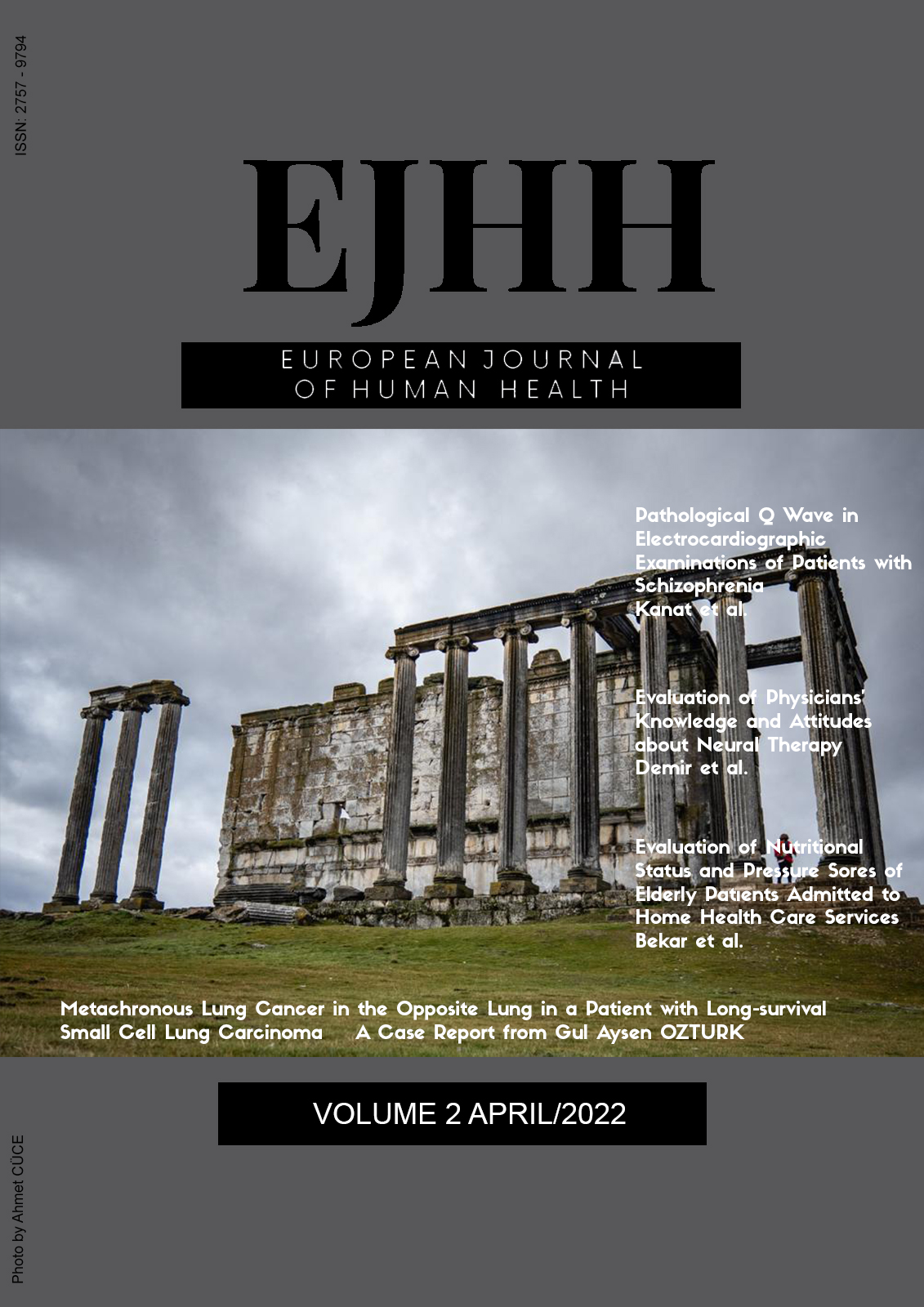Evaluation of Nutritional Status and Pressure Sores of Elderly Patıents Admitted to Home Health Care Services
Author :
Abstract
Keywords
Abstract
Aim: The aim of this study was to evaluate the nutritional status and decubitus status of elderly patients who applied to the Home Health Care Service at a training and research hospital and to determine the relationship between them.
Methods: The study was a descriptive and cross-sectional study that was conducted face-to-face with 364 elderly patients who matched the inclusion criteria. The Malnutrition Universal Screening Tool (MUST) screening test was used to measure the presence of malnutrition and was classified in three categories as low, medium and high risk. Physical examination was performed to detect the presence of pressure sores.
Results: Among the participants 30 patients (8.24%) had pressure sores and 113 of them (31.04%) had malnutrition. A positive relationship was found between nutritional deficiency and pressure sores. Malnutrition risk was determined using the MUST and 69.00% of the patients carried low risk, 25.80% carried medium risk and 5.20% carried high risk. There was a statistically significant difference between the number of people living with the patient at home, the duration of home health care and the duration of pressure sores (p <0.05). While there was no relationship between malnutrition and gender, income and educational status, a significant difference for age, marital status, caregiver presence, chronic disease and pressure sores was observed.
Conclusions: Pressure sores and malnutrition are not rare among the elderly patients admitted to Home Health Care Services and they are interrelated. Effective policies need to be established, implemented and monitored to prevent malnutrition and pressure sores. Home care providers and family doctors should take these situations into account when visiting patients at home.
Keywords
- 1. . Kanj LF, Wilking SVB, Phillips TJ. Continuingmedical education: Pressure ulcers. J Am Acad Dermatol. 1998; 38: 517-38.
- 2. Saghaleini SH, Dehghan K, Shadvar K, Sanaie S,Mahmoodpoor A, Ostadi Z. Pressure ulcer and nutrition. Indian J Crit Care Med. 2018; 22: 283.
- 3. Kaiser MJ, Bauer JM, Rämsch C, Uter W, Guigoz Y,Cederholm T, et al. Frequency of malnutrition in olderadults: a multinational perspective using the mininutritional assessment. J Am Geriatr Soc. 2010; 58(9): 1734-8.
- 4. Volkert D, Beck AM, Cederholm T, Cruz-Jentoft A,Goisser S, Hooper L, et al. ESPEN guideline on clinicalnutrition and hydration in geriatrics. Clin Nutr. 2019; 38: 10-47.
- 5. Stratton RJ, Hackston A, Longmore D, Dixon R,Price S, Stroud M, et al. Malnutrition in hospitaloutpatients and inpatients: prevalence, concurrentvalidity and ease of use of the ‘malnutrition universalscreening tool’ (‘MUST’) for adults. Br J Nutr. 2004; 92: 799-808.
- 6. Şahin A.D., Seyrek S., Ertürk A., Artantaş A.B. EvdeBakım Hastalarında Bası Yaraları ve HastalarınDemografik Özellikleri. Konuralp Med J / Konuralp Tıp Derg. 2017; 9: 14-8.
- 7. Niezgoda JA, Mendez-Eastman S. The effectivemanagement of pressure ulcers. Adv. Skin Wound Care. 2006; 19(1): 3-15.
- 8. McMahon MM, Bistrian BR. Host defenses andsusceptibility to infection in patients with diabetes mellitus. Infect Dis Clin N Am. 1995; 9: 1-9.
- 9. Guigoz, Y. Mini Nutritional Assessment: a practicalassessment tool for grading the nutritional state ofelderly patients. Facts Res Geyontol. 1994; 4: 15-59.
- 10. Çınar H, Kaya Y, Özyurt N, Çakır L, Ongun A.Palyatif Bakım Hastalarında Nutrisyonel DurumununDeğerlendirilmesi. Klin Tıp Aile Hekim Derg. 2016: 8(3): 15-18.
- 11. Yeniçağ R., Rakıcıoğlu N. Yaşlılarda Bası Yaraları veBeslenme Tedavisi. Sakarya Tıp Derg. 2012; 9: 387-12. Tsaousi G, Stavrou G, Ioannidis A, Salonikidis S,Kotzampassi K. Pressure ulcers and malnutrition:results from a snapshot sampling in a university hospital. Med Princ Pract. 2015; 24: 11-6.
- 13. Darnton-Hill I, Cogill B. Maternal and young childnutrition adversely affected by external shocks such asincreasing global food prices. J Nutr. 2010; 140: 162-14. Van Anholt RD, Sobotka L, Meijer EP, Heyman H,Groen HW, Topinková E, et al. Specific nutritionalsupport accelerates pressure ulcer healing and reduceswound care intensity in non-malnourished patients. Nutr. 2010; 26, 867-72.
- 15. Yue A, Marsh L, Zhou H, Medina A, Luo R, Shi Y, etal. Nutritional deficiencies, the absence of informationand caregiver shortcomings: a qualitative analysis ofinfant feeding practices in rural China. PloS one. 2016; 11: e0153385.





